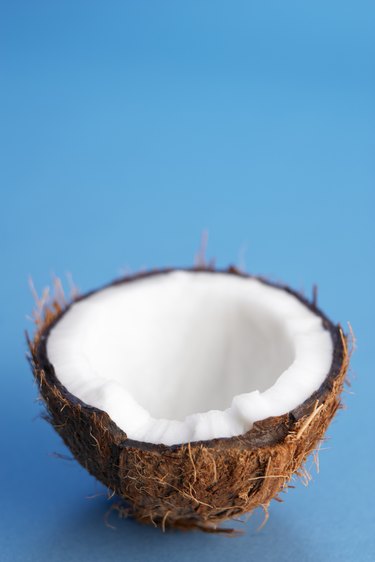
Coconuts (Cocos nucifera) are slow-growing, exceptionally useful, giant seeds. Coconuts, which grow on tall palm trees, provide everything from meat, called copra, and food-grade oil to durable fibers used to create clothing, shoes, hats and even temporary walls. All the parts of the coconut, from the tough outer husk to the meat inside either protect or feed the cotyledon as it develops. The cotyledon, classified as a monocotyledon, or singular, seed leaf developing from the base of the embryo, sits near the three germination pores, commonly called eyes.
Seeds of Change
Video of the Day
The coconut's cotyledon is part of the actual seed that would grow into a new coconut tree if planted. After germination, the cotyledon forms and goes through several changes. It starts at the base of the embryo and grows into a sponge-like mass that fills the entire inner cavity. During development, the cotyledon feeds off the coconut's meat, or endosperm, to create the nutrients necessary to grow the roots and shoots of a new plant. Once its work is done, the mass dissolves and the resulting plant begins to emerge from the one open pore.
Video of the Day
So it Grows
Selected coconut palms are used to produce seednuts for propagating more trees. Some seednuts germinate while still hanging on the tree, while others are picked or fall freely from the tree and take six to eight weeks to germinate. In commercial settings, the seeds that germinate the quickest are the best specimens for propagation purposes because they tend to produce a better crop. Coconuts typically reach the germination stage after 12 months on the tree.
Slow and Steady
Slow and steady wins the race, especially for coconuts. From the time a seed is planted, it can take five to nine years for the tree to start fruiting. It takes 10 to 12 months for coconuts to reach maturity, depending on how they will be used. Coconuts must be fully ripe to harvest the meat, or copra, used for everything from coconut flakes to animal feed. Coir, the tightly packed fibers of the outer husk, comes from coconuts picked about one month before maturity. Coir is used to create rope, yarn, and even mattress filler material.
Coconut Bread
Many coconuts, like those you find in the produce section, are harvested before they reach maturity, so the cotyledon has not had a chance to develop. If coconuts are allowed to germinate, the cotyledon, sometimes called an apple or bread, is harvested and eaten raw or toasted in the shell to provide a super sweet treat. When the coconut seedling emerges, the sprout, resembling celery, is also edible.